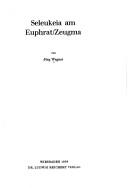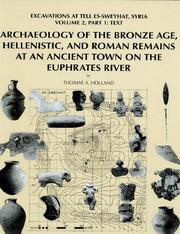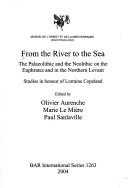| Listing 1 - 10 of 12 | << page >> |
Sort by
|
Book
ISBN: 9783447109284 3447109289 9783447109284 3447197021 Year: 2018 Volume: 6 Publisher: Wiesbaden: Harrassowitz,
Abstract | Keywords | Export | Availability | Bookmark
 Loading...
Loading...Choose an application
- Reference Manager
- EndNote
- RefWorks (Direct export to RefWorks)
Sprechen wir über die Geschichte und Kultur des Alten Orient, verwenden wir häufig die Begriffe Mesopotamien und Zweistromland – das Land zwischen Euphrat und Tigris. Diese beiden Flüsse waren prägend für die Zivilisationen, die sich an ihren Ufern entwickelten. Bisher existiert jedoch keine Studie, die sich der Frage widmet, wie die beiden Flüsse zur Zeit des Alten Orient wahrgenommen wurden und wie sie das Leben der Menschen prägten.Theresa Blaschke zieht zur Beantwortung dieser Frage Keilschrifttexte, die die beiden Flüsse namentlich nennen, aus allen Textgattungen und Zeitperioden der altorientalischen Geschichte zur Analyse heran. Da der Verlauf der beiden Flüsse zur Zeit des Alten Orient umstritten ist, ist eine detaillierte Auseinandersetzung mit ihrer Geografie zwingend erforderlich. Vor allem dem Tigris ist eine größere Bedeutung für die Region zuzuschreiben, als lange angenommen wurde. Darüber hinaus widmet sich die Studie den Themenbereichen der Herkunft und Schreibung der Flussnamen, der Überquerung der Flüsse und ihrer Wahrnehmung als Grenzen, der Nutzung der Flüsse als Verkehrswege, der Beschreibung der Flüsse als Wasserlieferanten und Überflussbringer sowie rituellen Aspekten und der Frage der Vergöttlichung der Flüsse. Auf diese Weise gibt Blaschke erstmals einen umfassenden natur- und kulturgeschichtlichen Überblick über Euphrat und Tigris im Alten Orient und das Leben an ihren Ufern.
Civilisation assyro-babylonienne. --- Antiquités assyro-babyloniennes. --- Euphrate, Vallée de l ' --- Tigre (cours d'eau) --- Euphrate (cours d'eau) --- Antiquités assyro-babyloniennes --- Euphrate, Vallée de l '. --- Alter Orient, historisch. --- Flussname. --- Hochschulschrift. --- Euphrat. --- Mesopotamien. --- Tigris.
Book
ISBN: 9781848853140 1848853149 Year: 2012 Publisher: London ; New York Tauris Parke Paperbacks
Abstract | Keywords | Export | Availability | Bookmark
 Loading...
Loading...Choose an application
- Reference Manager
- EndNote
- RefWorks (Direct export to RefWorks)
Roman provinces --- Provinces romaines --- Middle East --- Rome --- Euphrates River Valley --- Moyen-Orient --- Euphrate, Vallée de l' --- History --- History. --- Histoire --- Euphrate, Vallée de l'
Book
ISBN: 9783774938908 Year: 2014 Publisher: Bonn : Habelt,
Abstract | Keywords | Export | Availability | Bookmark
 Loading...
Loading...Choose an application
- Reference Manager
- EndNote
- RefWorks (Direct export to RefWorks)
Excavations (Archaeology) --- Inscriptions, Ancient --- Fouilles (Archéologie) --- Inscriptions antiques --- Commagene --- Euphrates River Valley. --- Turkey --- Commagène --- Euphrate, Vallée de l' --- Turquie --- Antiquities. --- Antiquités --- Fouilles (Archéologie) --- Commagène --- Euphrate, Vallée de l' --- Antiquités

ISBN: 3920153464 Year: 1976 Publisher: Wiesbaden : Reichert,
Abstract | Keywords | Export | Availability | Bookmark
 Loading...
Loading...Choose an application
- Reference Manager
- EndNote
- RefWorks (Direct export to RefWorks)
Excavations (Archaeology) --- Fouilles (Archéologie) --- Euphrates River Valley --- Zeugma (Extinct city) --- Euphrate, Vallée de l' --- Zeugma (Ville ancienne) --- Antiquities --- Antiquités --- Zeugma (Extinct city). --- Fouilles (Archéologie) --- Euphrate, Vallée de l' --- Antiquités --- Antiquities.
Book
ISBN: 2503991165 Year: 2001 Volume: 8 Publisher: Turnhout Brepols
Abstract | Keywords | Export | Availability | Bookmark
 Loading...
Loading...Choose an application
- Reference Manager
- EndNote
- RefWorks (Direct export to RefWorks)
Assyriologie --- Beschavingsgeschiedenis --- Geschiedenis van de Oudheid --- Histoire de l'Antiquité --- Histoire des civilisations --- Civilization, Assyro-Babylonian --- Civilisation assyro-babylonienne --- Euphrates River Valley --- Euphrate, Vallée de l' --- Antiquities. --- Antiquités --- Arameans --- -Ethnology --- History --- Assyria --- -Syria --- -Assyriology --- Archaeology --- Iconography --- Ideology --- Semi-nomadism --- Amorites --- History. --- -History --- -Arameans --- -Assyriology. --- Archaeology. --- Iconography. --- Ideology. --- Semi-nomadism. --- Amorites. --- Assyriology. --- -Civilization, Assyro-Babylonian --- Euphrate, Vallée de l' --- Antiquités --- Ethnology --- Syria
Book
ISBN: 2503510639 Year: 2000 Volume: 7 Publisher: Turnhout Brepols
Abstract | Keywords | Export | Availability | Bookmark
 Loading...
Loading...Choose an application
- Reference Manager
- EndNote
- RefWorks (Direct export to RefWorks)
Archaeology --- Human settlements --- Excavations (Archaeology) --- Civilization, Assyro-Babylonian --- Archéologie --- Etablissements humains --- Fouilles (Archéologie) --- Civilisation assyro-babylonienne --- Euphrates River Valley --- Syria --- Euphrate, Vallée de l' --- Syrie --- Antiquities. --- History --- Antiquités --- Histoire --- -Syria --- -Excavations (Archaeology) --- Archéologie --- Fouilles (Archéologie) --- Euphrate, Vallée de l' --- Antiquités
Book

ISBN: 9782503534954 2503534953 Year: 2015 Volume: 4 Publisher: Turnhout Brepols
Abstract | Keywords | Export | Availability | Bookmark
 Loading...
Loading...Choose an application
- Reference Manager
- EndNote
- RefWorks (Direct export to RefWorks)
The Middle Euphrates region extends between Jezirah and Northern Levant; it follows the course of the Euphrates from the south flanks of the Taurus mountains in Turkey almost to the modern border with Iraq. The settlement area drawn out between steppes in the east and in the west owes its particular character to just that life line with its rich soil but also to the trade routes meeting at the Euphrates Bend and connecting Anatolia to Mesopotamia, and the Syrian east to the Levant. Especially for the 3rd millennium, finds and findings from the area under consideration show great cultural variety and demonstrate the different influences by the neighbouring regions that meet here at the Euphrates river.0The international rescue excavations in the wake of dam projects in Turkey as well as in Syria yielded abundant material. The present study takes into account the results of more than forty sites. In agreement with the principles of ARCANE the richly illustrated account is divided along find groups and written by experts who supplemented their specific chronological findings thus arriving at a new periodization and terminology for the 3rd millennium. "The Middle Euphrates region extends between Jezirah and Northern Levant; it follows the course of the Euphrates from the south flanks of the Taurus mountains in Turkey almost to the modern border with Iraq. ... The international rescue excavations in the wake of dam projects in Turkey as well as in Syria yielded abundant material. The present study takes into account the results of more than forty sites. In agreement with the principles of ARCANE, this richly illustrated account is divided along find groups and written by experts who supplemented their specific chronological findings thus arriving at a new periodization and terminology for the 3rd milennium"--
Bronze age --- Chronology, Assyro-Babylonian --- Age du bronze --- Chronologie assyro-babylonienne --- Euphrates River Valley --- Euphrate, Vallée de l' --- Civilization --- Civilisation --- Excavations (Archaeology) --- Antiquities. --- Excavations (Archaeology). --- Syria --- Turkey --- Euphrate (cours d'eau) --- Middle East --- Syria. --- Turkey. --- Fouilles archéologiques. --- Euphrate, Vallée de l' --- Antiquities

ISBN: 1885923333 Year: 2006 Publisher: Chicago : Oriental Institute of the University of Chicago,
Abstract | Keywords | Export | Availability | Bookmark
 Loading...
Loading...Choose an application
- Reference Manager
- EndNote
- RefWorks (Direct export to RefWorks)
Excavations (Archaeology) --- Bronze age --- Fouilles (Archéologie) --- Age du bronze --- Euphrates River Valley --- Sweyhat, Tell (Syria) --- Euphrate, Vallée de l' --- Tell Sweyhat (Syrie) --- Antiquities. --- Antiquités --- Fouilles (Archéologie) --- Euphrate, Vallée de l' --- Antiquités --- Sweyhat Site (Syria) --- Tall es-Sweyhat (Syria) --- Tell es-Sweyhat (Syria) --- Syria --- Antiquities
Book
ISBN: 9781782977315 9781782977322 1782977317 Year: 2014 Publisher: Oxford Oxbow Books
Abstract | Keywords | Export | Availability | Bookmark
 Loading...
Loading...Choose an application
- Reference Manager
- EndNote
- RefWorks (Direct export to RefWorks)
According to archaeological evidence gleaned over more than 70 years, Mari appears to have been the most important city in northern Mesopotamia from its foundation at about 2950 BC to 1760 BC. Situated at the heart of a river system and progressively linked with an overland network, Mari was the city that controlled the relations of central and southern Mesopotamia with the regions bordering the Taurus and Zagros mountains to the north and east and the Mediterranean coastal zone to the west. Mari drew its power from this situation, and the role it played accounts for the particularity of its features, positioned as it was between the Syrian, Assyrian, Iranian, Babylonian and Sumerian worlds. The evidence shows that there was not one city of Mari, but three successive cities, each having specific features, although there is a striking permanence in the original forms. The first, City I, founded in about 2950 BC, was based on remarkable principles of city planning, including a broad regional development with the creation of canals for irrigation and transport, one more than 120 km long. In the 23rd century BC City II was founded using impressive technology in city planning. Probably destroyed by Naram-Sin of Akkad about 2200 BC, it was entirely reconstructed as City III by a new dynasty, the Shakkanakku. In the 19th century BC this was replaced by an Amorite dynasty, which ruled until Hammurabi of Babylon destroyed Mari in 1760 BC. The diversity of the information and material that has been recovered confirms Mari’s place as one of the best sources for understanding the brilliant Mesopotamian civilisation that developed between the beginning of the 3rd and the end of the 1st millennium BC.
Excavations (Archaeology) --- Architecture --- Social archaeology --- Capitals (Cities) --- Regionalism --- Fouilles (Archéologie) --- Archéologie sociale --- Capitales --- Régionalisme --- History --- Histoire --- Mari (Extinct city) --- Syria --- Euphrates River Valley --- Mari (Ville ancienne) --- Syrie --- Euphrate, Vallée de l' --- Antiquities. --- Antiquities --- Antiquités --- Archéologie --- Archeologische vondsten. --- Opgravingen. --- Architecture. --- Capitals (Cities). --- Excavations (Archaeology). --- Regionalism. --- Social archaeology. --- History. --- Euphrates River Region --- Mari (Syrië) --- Middle East --- Syria. --- Mari (Extinct city). --- Mari (Syrië). --- Fouilles (Archéologie) --- Archéologie sociale --- Régionalisme --- Euphrate, Vallée de l' --- Antiquités

ISBN: 1841716219 Year: 2004 Volume: 1263 Publisher: Oxford, England : Archaeopress,
Abstract | Keywords | Export | Availability | Bookmark
 Loading...
Loading...Choose an application
- Reference Manager
- EndNote
- RefWorks (Direct export to RefWorks)
Paleolithic period --- Neolithic period --- Stone implements --- Pottery, Prehistoric --- Paléolithique --- Néolithique --- Outils de pierre --- Céramique préhistorique --- Copeland, Lorraine --- Middle East --- Euphrates River Valley --- Moyen-Orient --- Euphrate, Vallée de l' --- Antiquities. --- Antiquités --- Festschrift - Libri Amicorum --- Paléolithique --- Néolithique --- Céramique préhistorique --- Copeland, L. --- Euphrate, Vallée de l' --- Antiquités --- Flint implements --- Lithic implements --- Implements, utensils, etc. --- Debitage --- Prehistoric pottery --- Industries, Primitive --- Eolithic period --- Old Stone age --- Palaeolithic period --- Stone age --- New Stone age --- Euphrates Valley --- Industries, Prehistoric
| Listing 1 - 10 of 12 | << page >> |
Sort by
|

 Search
Search Feedback
Feedback About UniCat
About UniCat  Help
Help News
News